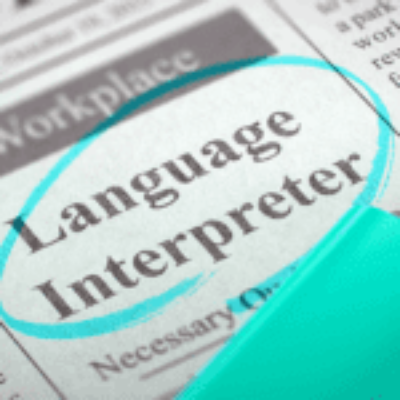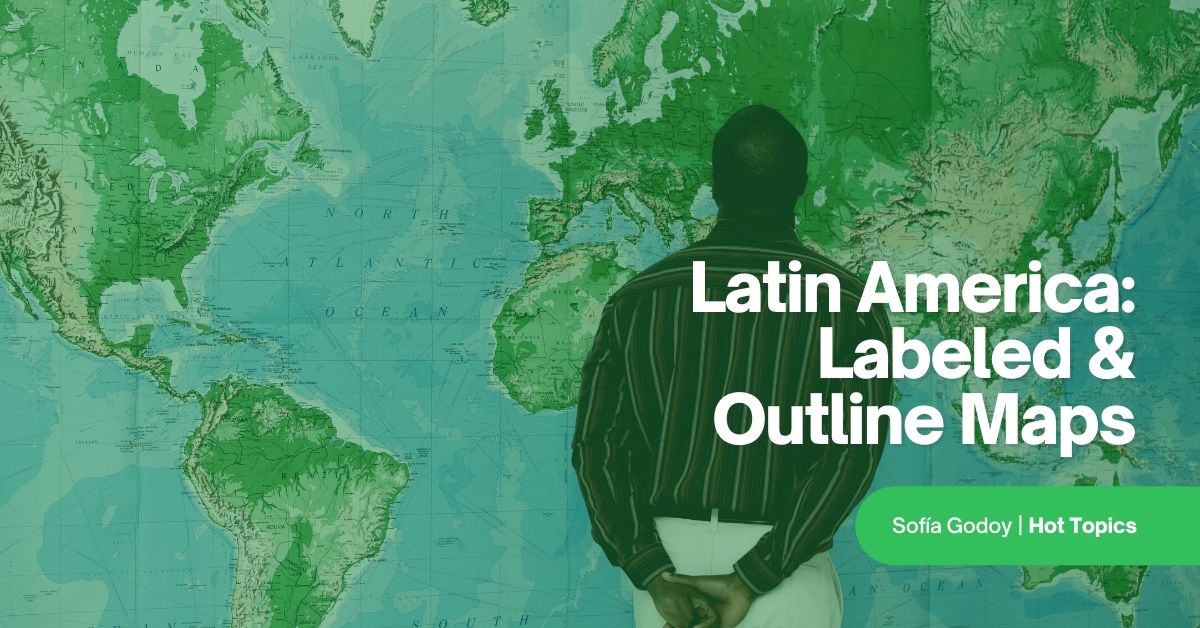
Latin America: Labeled & Outline Maps [Free Printables]
Latin America is a diverse region that encompasses 21 countries and a melting pot of cultures and languages.
Teaching Spanish students about this fascinating region is an ideal way to awaken their interest in exploring the world.
Do you need help preparing a fun and engaging lesson on Latin America?
Look no further!
Studying geography with a labeled map gives your child an awareness of space and place, along with other interesting benefits.
Bring geographical and cultural insight to your Spanish classroom with this lesson. Each section features a free labeled map, an outlined map for students to color, and a worksheet activity.
Table of Contents:
- Printable Labeled Map of Latin America and Worksheet
- Where Is Latin America?
- Latin America Facts
- Central America Free Maps and Worksheet
- Where Is Central America?
- Central America Facts
- South America Free Maps and Worksheet
- Where Is South America?
- South America Facts
- Learn More About Latin America’s Richness
Printable Labeled Map of Latin America and Worksheet
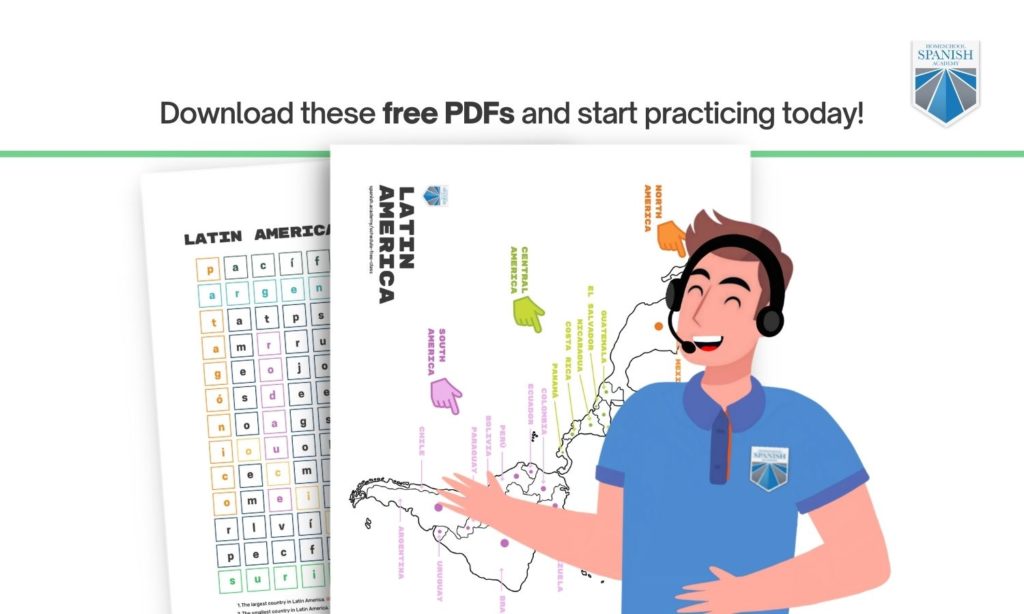
Download FREE Printable Labeled Map of Latin America and Worksheet!
Type your name and email to get a printable labeled map of Latin America and a worksheet!
Where Is Latin America?
América Latina or Latinoamérica (Latin America) sits below Canada and the United States. The region contains Mexico, Central America, and South America.
Its territories include six Central American countries, 10 South American nations, and one North American country.
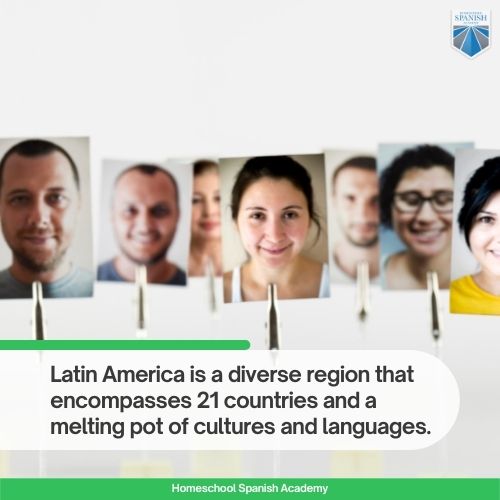
Check out: A Kid’s Guide to the Globe in Spanish
Weather
El clima (the weather) in Latin America is diverse because of its wide range of altitudes.
The region is traversed by el ecuador (the equator). This dividing line separates Latin America into el hemisferio Norte (Northern Hemisphere) and el hemisferio Sur (Southern Hemisphere).
This area near the equator is one of the hottest regions in the world. This makes Latin America stand out for its tropical weather. It also has cool and dry areas.
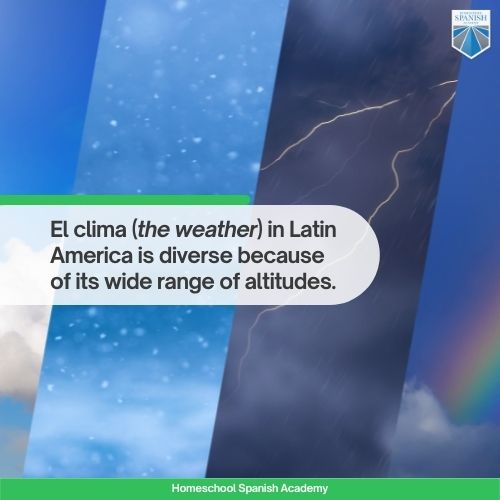
Geography
La cordillera Americana (American mountain range) is in Latin America. Mexico is the starting point of the Sierra Madre, which spans across Central America. In South America, the mountain range becomes the Cordillera de los Andes (Andes Mountain Range).
Due to these massive mountain ranges, Latin America has hundreds of volcanoes and mountains. The tallest mountain is the Cerro Aconcagua, and the tallest volcano is the Nevado Ojos Salados. Both peaks are in Argentina.
The Latin America map features rivers of great natural importance. The largest river in Latin America is the Amazonas (Amazon river). It flows from Peru to Bolivia, Ecuador, Venezuela, and the Brazilian Atlantic shores.
Latin America’s largest lake is Lago Maracaibo in Venezuela. The largest desert is in Argentina and Chile, and it’s called the desierto Patagonico (Patagonian desert).
See also: Desert Animals and Plants in Spanish
Latin America Facts
- Latin America borders the oceano pacifico (Pacific Ocean) to the west and the el oceano atlantico (Atlantic Ocean) to the east
- The region is home to over 650 million Latinos and Latinas
- Latinos encompass indigenous, Afro-Latino, and mestizo (mixed) cultures.
- Latin America contains 12% of Earth’s productive soils
- It’s home to one-fifth of the world’s forests
- Latin America has six megadiverse countries
- The majority of Latin American countries speak languages that derive from Latin
- The largest city in Latin America is Sao Paulo, Brazil with a population of 12 million

Central America Free Maps and Worksheet
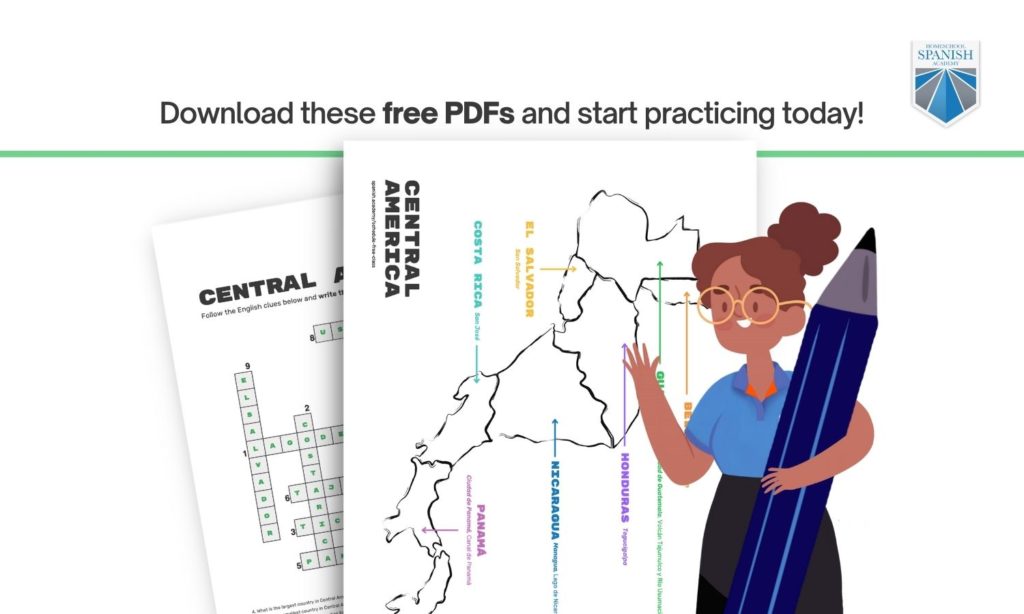
Download FREE Printable Labeled Map of Central America and Worksheet!
Type your name and email to get a printable labeled map of Central America and a worksheet!
Where Is Central America?
On the labeled map of Latin America, América Central or Centroamerica (Central America) is south of Mexico. This region contains seven countries: Belize, Guatemala, Honduras, El Salvador, Nicaragua, Costa Rica, and Panama.
Weather
Central America stands out for its tropical weather due to its proximity to the equator. The majority of Central American countries only have two seasons: dry and wet.
During the dry season, rain is scarce and the terrain becomes arid. In the rainy season, afternoon and evening rain is predominant.
Central America’s position between two oceans makes it vulnerable to huracanes (hurricanes). Hurricane season is from June to November.
Of all the Central American countries on the labeled map, Guatemala has the coldest temperatures. A range of microclimates occurs due to the various elevations in the mountain chains.
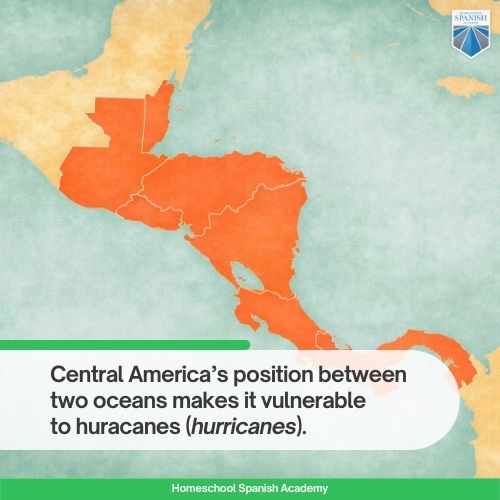
Geography
Central America is home to 27 active volcanoes.
The region sits atop six placas tectonicas (tectonic plates), which makes it vulnerable to tremors and earthquakes. The tallest peak in Central America is Tajumulco in western Guatemala, which stands at 13,813 feet above sea level.
The largest river in Central America is the Usumacinta. It is 3,684 feet long and marks the border between Mexico and Guatemala. The largest lake in Central America is Lake Nicaragua.
Recommended reading: 13 Inspiring Facts About Lake Nicaragua
Central America Facts
- Geographically, Belize is considered a part of Central America but not of Latin America. The country was colonized by the British and the official language is English. Spanish and creole are also widely spoken.
- The largest country in Central America is Nicargua. The smallest country is El Salvador.
- The biodiversity of Central America is incredibly rich considering the size of the territory.
- Guatemala and Costa Rica are two of the world’s megadiverse countries
- The Canal de Panamá (Panama Canal) connects the Atlantic and Pacific Oceans
- The largest city in Central America is Guatemala City
- The population of Central America is close to 45 million.
- The people from this region are centroamericanos (Central Americans), but every country has its own nickname, for example:
- chero/a – Salvadoran
- chapin/a – Guatemalan
- catracho/a – Honduran
- nica (never nico) – Nicaraguan
- tico/a – Costa Rican
Discover the interesting Origin and History of the Term Chapín in Guatemala.

South America Free Maps and Worksheet
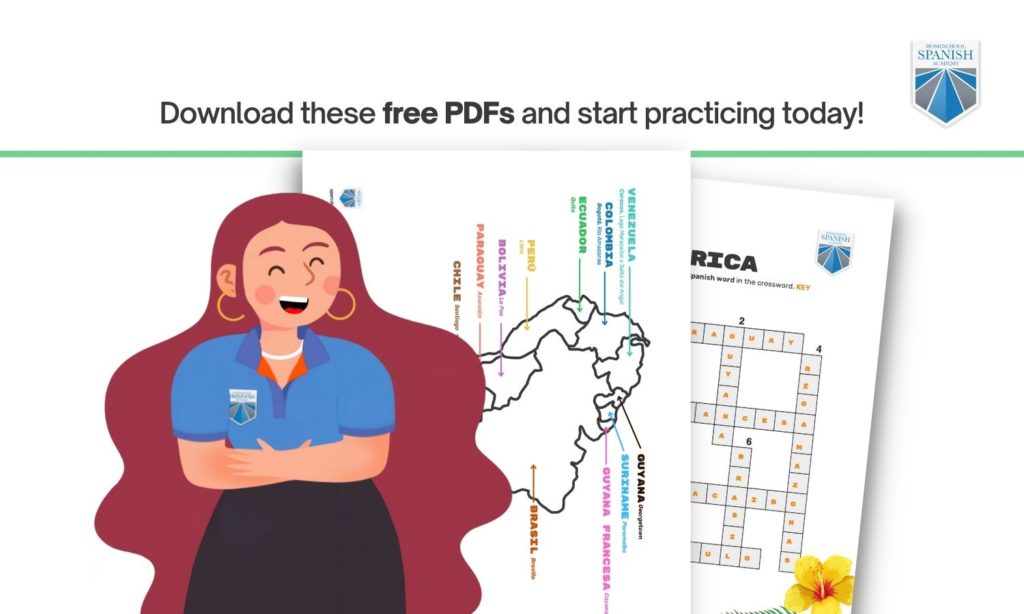
Download FREE Printable Labeled Map of South America and Worksheet!
Type your name and email to get a printable labeled map of South America and a worksheet!
Where Is South America?
Observing the labeled map of Latin America, you’ll notice South America starts in Colombia and spans 13 countries to the southern tip of Argentina.
Weather
South America’s proximity to the equator and the abundance of tropical rainforest make the northern part of the region stand out for its humid and hot climate. The Amazon basin has constant rainfall. Colombia, Ecuador, Suriname, and Guyana are the wettest countries in the area.
The weather in South America is diverse. Further south, the weather has defined seasons. with a hot summer and a cool winter. The Andes mountains reach near-Arctic climate conditions and freezing winters.
Geography
South America is home to some of the world’s most important water bodies and forests, as well as the Andes Mountains, which contain the tallest peaks in Latin America.
Lakes and rivers in South America also have large proportions. As mentioned above, Lago Maracaibo is the largest lake on the continent. The Amazon river is the largest river in Latin America and the second-largest river in the world.
El Amazonas is of utmost importance to life on our planet. The rainforest and basin extends through five countries and contains highly valuable natural resources. It produces 6% of the world’s oxygen.
Inspire your students to value nature with this free lesson for kids on Facts About the Amazon Rainforest in Spanish.

South America also has savannas, grasslands, prairies, glaciers, wetlands, and coast.
The tallest point in South America is the Cerro Aconcagua in Argentina. It stands at 22,838 feet above sea level.
South America is also home to the tallest waterfall in the world. It’s called el Salto del Angel (Angel Falls), and it’s in Venezuela.
South America Facts
- The largest country in South America is Brasil (Brazil) and the smallest is Guyana Francesa (French Guiana)
- Although Guyana, French Guiana, and Suriname are geographically considered part of South America, they are not considered Latin American countries because their official language doesn’t derive from Latin.
- In Guyana the official language is English, in French Guiana the official language is French, and in Suriname the official language is Dutch.
- In Paraguay, both Spanish and Guaraní are official languages
- In Brazil, the official language is Portuguese
- The population of South America is close to 430 million people
Hand-picked for you: The Rise of the 6 Largest Cities in Latin America
Learn More About Latin America’s Richness
This free lesson with labeled maps is sure to bring effective and fun teachings to your Spanish classroom! Use it as a way to encourage your children to explore the world. As they get older, look for opportunities that allow them to travel abroad and experience other cultures.
Kids who learn Spanish have a deeper understanding of diversity. The chances your child will encounter Spanish speakers in their community are higher than ever. Being bilingual allows kids to communicate effectively with people from different backgrounds.
Take advantage of your children’s willingness to learn and sign them up for a free trial class with an experienced Homeschool Spanish Academy teacher.
HSA-certified teachers are native speakers from Guatemala. The Spanish immersion you get from our programs exceeds expectations and helps move your child toward fluency. Our tailor-made programs adapt to your needs, schedule, and offer affordable pricing.

Join one of the 40,000 classes that we teach each month and you can experience results like these

“This is the best way for your kid to learn Spanish. It’s one-on-one, taught by native Spanish speakers, and uses a curriculum.”
– Sharon K, Parent of 3

“It’s a great way to learn Spanish, from native Spanish speakers in a 1-on-1 environment. It’s been fairly easy to schedule classes around my daughter’s other classes. The best value for us has been ordering multiple classes at a time. All the instructors have been great!”
– Cindy D, Parent of 3

“HSA offers very affordable, quality, one on one classes with a native speaker. My son has greatly benefited from taking classes. We have seen his confidence increase as well as his pronunciation improve, because he learns from a native Spanish speaker. HSA has quick, personal customer service. Our family has been very pleased with our experience so far!”
– Erica P. Parent of 1
Want to learn more about Latin American culture? Check out our latest posts!
- Celebrating Culture and Joy: The Magic of Carnival in Spanish-Speaking Countries
- 15 Mouth-Watering National Dishes of Latin America
- Discovering The Mayan Languages
- The 10 Most Common Spanish Surnames in The U.S
- Everything About Mexican Christmas Traditions
- What Is the Hispanic Scholarship Fund? Is It Legit?
- A Spanish Guide to Thanksgiving Food Vocabulary
- How Did All Saints Day Celebrations Started?
- 29 Cool and Catchy Spanish Phrases To Use With Friends [+Audio] - January 8, 2023
- A Fun Kids’ Guide to Opposites in Spanish (Free Lesson and Activities) - December 29, 2022
- 10 Fun Spanish Folk Tales for Kids - December 10, 2022


